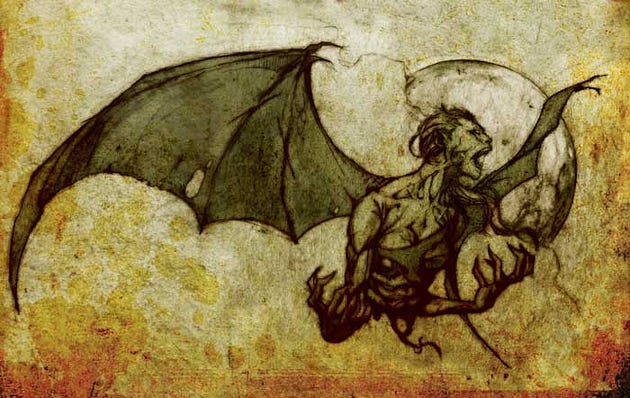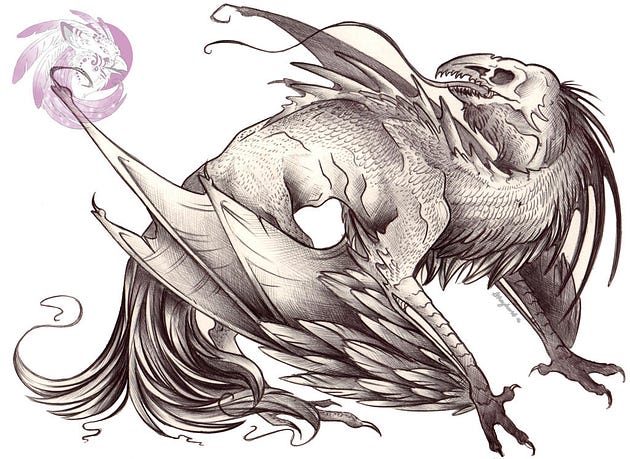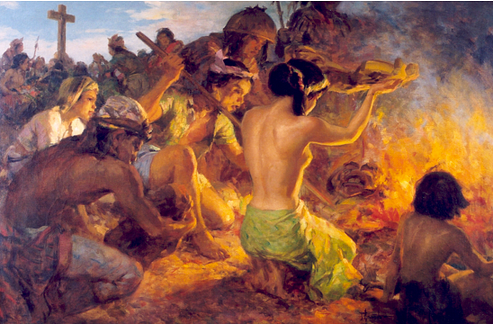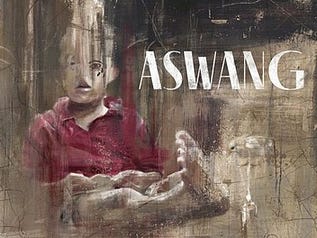Beware the Tik-Tik: The Aswang and Other Monsters of the Philippines

Image from Young Philipinas
Let’s talk about one of the most chilling creatures ever crawling out of Filipino folklore: the Aswang.
This monster is a shapeshifter, a deceiver, a hunter that slips between worlds whose appearance is both human and monstrous. Depending on who you ask, the Aswang can be a beautiful woman by day, a flying predator by night, or even a pig walking backward in the dark. Some say it can perch behind trees, glide through the air, or walk among us without revealing its true face. The scariest part is that the Aswang isn’t just one creature. It’s many.
In Filipino stories, “Aswang” is an umbrella term that covers a whole spectrum of horrors: vampires, witches, corpse-eating ghouls, basically all the spooks of the world. The stories shift from region to region, but the themes remain the same: deception, hunger, and fear.
Some tales describe a flying torso with a straw-like tongue used to drain blood or steal unborn children. Others speak of creatures that dig up graves or animals whose feet face the wrong direction, so no one knows where they came from. People still whisper about them in rural areas and take precautions, like wearing amulets or sprinkling salt near windows, and other rituals that blend superstition and survival.
The Aswang isn’t bound by geography, either. Filipino migrants carried their legend across oceans, especially to early Filipino communities in Louisiana like Saint Malo and Manila Village. There, myths evolved to fit new surroundings. Some even believed marrying outside their culture could “break the bloodline,” as non-Filipinos were thought to be immune to the curse.
But the Aswang myth is about monsters as it is about history. Folklorist Herminia Meñez suggests that during Spanish colonization, stories of the Aswang were twisted to demonize the babaylan, Filipina shamans and spiritual leaders who held power in their communities. These women, seen as threats by colonial rulers, were recast as witches and man-eaters (sound familiar?). The infamous Manananggal, with her beauty by day and horrific form by night, became a weapon of fear against powerful women.
Still, the Aswang’s origins go far deeper than colonization. Similar beings appear across Southeast Asia, like the penanggalan of Malaysia and the Krasue of Thailand, that share the same hunger for blood and viscera. But in the Philippines, the Aswang took on its unique form, steeped in local beliefs and shaped by centuries of storytelling.
The Many Faces of the Aswang
Part of what makes the Aswang so terrifying is its ability to blend in. By day, it looks ordinary — quiet, polite, maybe even kind. You might see one shopping at the market, walking to church, or chatting with neighbors. But when night falls, it becomes something else entirely. There’s no single, official version of the Aswang; it’s more like a family of monsters that overlap and mutate depending on the storyteller. Most researchers break them down into five main types, though in practice, the lines blur and the stories mix.
Vampire Aswang appear as beautiful women who drain their lovers’ blood at night through a long, straw-like tongue. Viscera Suckers — like the famous Manananggal — detach their upper bodies, sprout wings, and hunt pregnant women, feeding on fetuses through open windows. Weredogs transform into animals, stalking lonely roads and remote villages. Witches curse people with sickness or pain, and Ghouls feast on corpses in cemeteries.
It’s not uncommon to hear of hybrids, or witches who also suck blood, and corpse-eaters who can fly. The Aswang adapts, changing with every retelling, like the fears it represents.
Now, let’s look closer at a few of the most infamous kinds that haunt Filipino nights.
The Manananggal

Arguably the most recognizable version of the Aswang, the Manananggal gets her name from the Tagalog word tanggal, meaning “to separate.” And that’s precisely what she does.
She splits her body in half at night, leaving her lower torso behind while her upper half sprouts massive bat-like wings and takes to the sky. She prowls the darkness searching for pregnant women, using her long, needle-thin tongue to drink the blood of the unborn or suck out organs through cracks in walls and roofs.
By day, she’s often described as a beautiful woman. Sometimes she’s older, other times, she is charmingly ordinary. The horror lies in that transformation: the idea that your friendly neighbor could be a literal predator. According to folklore, if you ever find the Manananggal’s abandoned lower half, you can stop her by sprinkling salt, ash, or crushed garlic on it. When she tries to reconnect, she’ll fail and burn when the sun rises.
Even now, she appears in comics, films, and horror stories in the Philippines and abroad. But in rural towns, she’s not just a story. Pregnant women still guard their windows with salt, just in case.
The Tik-Tik and the Wak-Wak
Press enter or click to view image in full size

The Tik-Tik is another winged horror, named after its eerie sound: tik-tik… tik-tik… The catch?
The louder the sound, the farther away it actually is.
When it grows faint, that means it’s near.
That cruel trick has made the Tik-Tik a symbol of deception and proof that danger often hides behind comfort. It may look like a normal person or even a stray animal by day. But when night comes, it hunts, using mimicry and silence to sneak up on the unsuspecting.
Then there’s the Wak-Wak, named for the flapping of its enormous wings. Similar to the Tik-Tik, it’s often mistaken for the Manananggal — but it’s far more brutal. The Wak-Wak doesn’t feed delicately; it tears its victims apart with talons and a sharp beak. Some say its legend was inspired by sightings of ancient, giant bats whose fossils were once mistaken for humanoid remains.
Even today, if villagers hear that wak-wak sound at night, they hurry indoors and bar their doors. Because once it’s in the air, you’re better off praying than running.
The Corpse-Eater

While some Aswang crave living flesh, others prefer the dead. These corpse-eating Aswangs, sometimes called balbal or ungo, are said to dig up fresh graves and feast on the remains. In some tales, they leave behind decoy bodies of plants or straw to trick families into thinking their loved one is still there.
Each region has its own variation. In Zamboanga, the Ungo is said to sneak out at night to steal bodies and cook them for her neighbors. Eat the meal, and you become one of her kind. Among the Apayao people, there’s Wirwir, a grave-haunting creature who must be appeased with offerings so he doesn’t disturb burials. And in Albay, there’s a story about an Aswang who disguises human flesh as pork to feed her family, a dark parody of domestic life.
The Animal Shapeshifter

Then there are the animal forms, and perhaps, the most insidious of the Aswang. Pigs that walk backward, the dogs with human eyes, and the cats that stare too long are among the most feared. These animal shapeshifters slip through villages unnoticed, blending in while they hunt. Some are said to create doppelgängers from leaves or wood to replace the people they kill, fooling families into mourning a false corpse.
And just like the Tik-Tik and Wak-Wak, they use sound as a weapon. The rule is always the same: the louder it seems, the safer you are. When the noise fades into silence or a whisper… that’s when the Aswang is close.
Becoming an Aswang
Things get even darker when we start asking how someone becomes an Aswang. Unlike vampires or werewolves from Western legends, there’s no bite or curse to blame; it’s a choice or ritual.
The transformation begins with a fertilized chicken egg in one of the most infamous stories. The person ties the egg to their stomach for several nights until, one evening, the tiny black chick inside supposedly passes into their body (alive). The empty shell is then buried in a bamboo tube with coconut oil and chicken dung, forming a twisted charm. From that point on, the person is no longer fully human. They carry something dark inside them, something alive and hungry. Over time, they gain unnatural strength, shapeshifting powers, and an insatiable urge to feed.
When an Aswang nears the end of its unnatural life, it must pass on its power. This happens in a horrifyingly intimate way: mouth to mouth. The dying Aswang spits the living chick into the mouth of its chosen successor. The act is like a grotesque form of inheritance. A kiss that seals a monstrous legacy. It’s a disturbing image, but rooted in older Filipino beliefs about swallowing amulets or charms for protection or power. In this case, the “charm” is more than symbolic because it’s alive, and it changes you from within. This ritual sounds horrific, but it’s tangled with history.
In pre-colonial times, powerful women called babaylan served as healers, priestesses, and spiritual leaders. When the Spanish arrived, they feared and vilified these women, branding them as witches and demonic shapeshifters. The Aswang myth became a colonial tool and an accusation used to silence women who held influence. Over time, their sacred roles were twisted into monstrous ones, their power reframed as something evil.

Even the egg in the Aswang ritual has layers of meaning. Across cultures, eggs represent life, fertility, and creation. But here, that symbol is warped. The chick becomes a vessel of undeath, a dark parody of birth. Some superstitions even claim that eating an overdeveloped balut — a fertilized duck egg — could trigger transformation. That fear led to certain culinary habits, like adding vinegar or salt to reveal “spoiled” or cursed food. What started as folklore quietly seeped into daily life.
Not every legend follows the same path to transformation. Some say people can choose to become an Aswang through dark rituals, rubbing cursed oils on their skin, or swallowing enchanted objects. Others say the curse spreads through contact, like eating food prepared by an Aswang or even being born into the bloodline. There are stories of families quietly passing the secret from generation to generation, and of unsuspecting people who turn only after consuming cursed meat.
For centuries, these tales weren’t just bedtime stories but warnings. And in some parts of the Philippines, they still are. What keeps the Aswang alive in the collective imagination are the encounters. Ask almost anyone from the provinces, and they’ll have a story, or know someone who does.
The Stories of Aswang
One popular account comes from a woman named Emelia, affectionately known as Lola Emelia, who grew up in a rural stilt house with her newlywed brother and pregnant sister-in-law. Late one night, she heard panting under the floorboards. Thinking it was a dog, she peered through the bamboo slats and locked eyes with something that had glowing red eyes and thick, matted fur. Her brother rushed out, wielding a stingray tail talisman that was said to repel Aswangs, but the creature was gone. Only claw marks in the soil remained.
Another story from Capiz, a place often called the “Aswang capital” of the Philippines, people still whisper about pigs that walk backward. One group of teens claimed to have seen one crossing the road before it bolted into the trees and moved in reverse the whole way.
Then there’s the story from Iloilo, where a pregnant woman awoke to the sound of tik-tik circling her roof. Her husband found claw marks the next morning. A healer later told them they were being hunted. Similar stories go back decades, even before World War II, when belief in the Aswang was deeply rooted in the region.
Modern stories have migrated online, told by Filipinos and Filipino Americans alike. In one chilling Reddit post, a man described visiting his wife’s family in the provinces. His pregnant wife was approached at the market by an old woman who somehow knew she was expecting. That night, they heard heavy movement on the roof. When his brother-in-law climbed up to check, he saw something vaguely human leap into the dark. The next morning, neighbors spoke of a pig sniffing around the house. After installing cameras, the noises stopped… but they never found out what it was.
One of the most famous stories tells of a man who killed a black pig that had been haunting his home, believing it to be the source of his wife’s mysterious illness. When he brought the carcass to the police, it had turned into a human body. The man was arrested for murder. Still, the locals insisted he had saved his wife from an Aswang.
Even in the age of smartphones and city lights, these tales continue. In Cavite, a group of women claimed they saw a Tik-Tik outside their bathroom window while staying with a pregnant friend. They heard wings. Then silence. And remember, in Filipino folklore, silence is never a good sign because it means the creature is already close. Growing up in the provinces, kids learn simple rules: eat before dark, stay indoors at night, and never respond to dogs barking or strange noises from the sky.
The Aswang’s Evolution
Beyond the horror, the Aswang also carries meaning. It represents fear of the unknown, distrust of outsiders, and the anxieties surrounding sickness, death, and female autonomy. Many of the creatures in these stories are women: independent, beautiful, and mysterious. In older communities, those traits alone were enough to draw suspicion. Some scholars argue that Aswang stories functioned as social warnings, discouraging rebellion, independence, or any behavior that challenged patriarchal norms.
Yet, like all myths, the Aswang has evolved.

In recent years, it’s reemerged as a monster of folklore and a symbol of cultural identity and resistance. Alyx Ayn Arumpac’s documentary Aswang (2019) uses the creature as a metaphor for the fear and violence of Duterte’s drug war. Instead of wings and claws, the monsters in this story wear human faces and those complicit in cruelty.
The Aswang has also found a home in pop culture. Movies like Tiktik: The Aswang Chronicles (2012) and its sequel Kubot turn the legend into high-octane, gory action. The long-running Shake, Rattle & Roll anthology reinterprets the myth repeatedly, each version reflecting the fears of its time, from isolation to corruption to betrayal.
In comics and streaming, the creature thrives too. Trese, the hit Filipino series turned Netflix adaptation, reimagines Aswang as part of an underworld crime syndicate, both terrifying and tragically human. The Aswang Project archives these stories online, preserving their variations and meanings for future generations.
Press enter or click to view image in full size

Even the Western media has taken notice. Shows like Grimm and Lost Girl have featured the Aswang, weaving it into broader supernatural worlds. It’s also crept into online horror games and creepypasta stories, proving that fear, like folklore, travels easily across borders.
Today, places like Capiz celebrate their once-feared legend through festivals filled with costumes, dance, and storytelling. What was once a stigma has become a source of pride, and a way of honoring cultural heritage through the myth that once haunted it. Whether you believe the Aswang is myth or memory, one thing’s certain: Halloween is the perfect time to let old stories breathe again.
To listen to the audible version, check out The Ominous Archives Podcast!
References
Aswang. (n.d.). Mythology.net. https://mythology.net
Ghouls in Philippine folklore. (n.d.). AswangProject.com. https://www.aswangproject.com
Looking into the eyes of Aswang: Alyx Arumpac’s Aswang (2019) as a “gothumentary” of the Philippine war on drugs. (n.d.).
Manananggal: A mythical creature from Philippine folklore. (n.d.). MythicalEncyclopedia.com. https://mythicalencyclopedia.com
Monstrum from PBS. (n.d.). PBS. https://www.pbs.org/show/monstrum
Nadeau, K. (2011). Aswang and other kinds of witches: A comparative analysis. Philippine Quarterly of Culture and Society, 39(3–4), 250–266.
Original horror story — My Lola’s story about the Aswangs. (n.d.). Steemit.com. https://steemit.com
Reddit discussion: Aswang video — What’s your verdict and experience? (n.d.). Reddit.com. https://www.reddit.com
The real Aswang in today’s society. (n.d.). Heraldofilipino.org. https://www.heraldofilipino.org
The mystique of the Tiktik Aswang. (n.d.). Vocal.media. https://vocal.media
Tiktik: The Aswang Chronicles. (n.d.). IMDb. https://www.imdb.com
Wakwak: Vampire bird in Philippine mythology. (n.d.). WarsAndHistory.com. https://warsandhistory.com
What really is an Aswang? (n.d.). Owlcation.com. https://owlcation.com

Dive into the chilling world of horror literature and explore spine-tingling tales crafted by Samantha Almeida. Follow me on social media for the latest updates, exclusive content, and a community of fellow horror enthusiasts. Remember, the shadows are always watching—stay connected and keep the scares alive!
Home | About | Services | Privacy Policy
